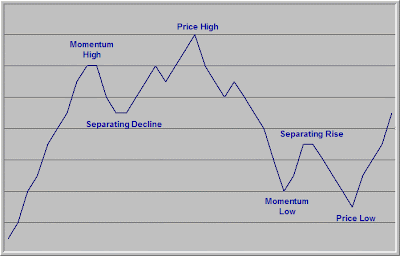BSD
Veteren member
- Messages
- 3,819
- Likes
- 988
From the good Mr. Brett Steenbarger:
"An Introduction to Trading: Cycles and Their Implications
In the last post in this series, we took a look at the structure of price changes in the stock market. The key idea was that the broad indexes move in aperiodic cycles, with periods of upward and downward trending punctuated with periods of distribution. With this notion of cyclical structure as part of a conceptual framework for trading, it is possible to generate ideas of likely market action based upon: 1) where we are at in the current market cycle and 2) where the current cycle is situated within cycles at longer time frames. As we move forward in this e-book, I'll be providing specific examples of cyclical structures, so that it will be easier for you to recognize them as they are occurring.
This view of market behavior carries a number of implications and helps explain several common market observations:
1) Chart Patterns Make Sense - The literature of technical analysis emphasizes such chart formations as double tops and bottoms, head and shoulders formations, cups-and-handles, etc. All of these naturally follow from a cyclical view of markets in which momentum peaks and valleys tend to precede price peaks and valleys. Similarly, the technical literature is replete with oscillators and ideas about trading divergences in overbought/oversold; RSI; stochastics; MACD; etc. These divergences also make sense within a cyclical view of price change, as markets lose momentum prior to reversing. Even the formulations of Elliott and Gann theorists make sense as ways of conceptualizing phases of momentum within cyclical patterns.
2) No One Strategy Always Wins - Go back to the idealized chart of cyclical price change from the prior post. During the market moves between price lows and momentum highs and between price highs and momentum lows, trend following strategies will tend to work. During periods between momentum highs and price highs and between momentum lows and price lows, we will tend to see countertrend (reversal) strategies working. During the period between price highs and momentum lows, we'll tend to see volatility expand; during the period between momentum highs and price highs, we'll tend to see volatility dry up. Using the same strategy across all phases of market cycles will result in periods of uneven performance.
3) No Two Cycles Are Identical - Cycles are nested within cycles; as a rule, the larger the time frame, the larger the amplitude of the cycle. Thus, markets will tend to move more (i.e., display greater price variability) over a monthly time frame than over a daily one. Because larger time frames exert influences on shorter ones and multiple time frames are nested, no one cycle is identical to others. Traders looking for precise patterns or timing rules to recur are apt to face disappointment. The goal of the trader should be to try to *identify* cycles that we're in and frame viable hypotheses from this identification. That is very different than trying to predict precise price action from a given cyclical formulation. Once again, I'll be providing examples of this as we move along.
4) Trade Execution and Management - An understanding of cycles will help us differentiate the generation of trade ideas (which occurs at one cycle level) and the execution and management of that trade (which occurs at one time frame lower). This is a very important concept that will guide work on improving our trading performance.
The value of a conceptual framework is its ability to guide our understanding and behavior and organize our observations in meaningful ways. Psychoanalysis is one framework for understanding people; behaviorism is another. Buddhism is one framework for spiritual life; Judaism is another. A useful framework is one that speaks to you and that you can actually apply in constructive ways. In this course, we'll be building one framework that has made sense to me over 30+ years of trading. Your job is to consider it, find what--if anything--speaks to you, and then integrate that information into your own experience and understanding.
The goal of this "Introduction to Trading" is to make you your own guru; to help you sharpen your own views and understandings of markets. The idea is not to follow me, but to lead yourself. My job is to offer a few tools that might be useful in that process.
LINK:
TraderFeed: An Introduction to Trading: Cycles and Their Implications
"An Introduction to Trading: Cycles and Their Implications
In the last post in this series, we took a look at the structure of price changes in the stock market. The key idea was that the broad indexes move in aperiodic cycles, with periods of upward and downward trending punctuated with periods of distribution. With this notion of cyclical structure as part of a conceptual framework for trading, it is possible to generate ideas of likely market action based upon: 1) where we are at in the current market cycle and 2) where the current cycle is situated within cycles at longer time frames. As we move forward in this e-book, I'll be providing specific examples of cyclical structures, so that it will be easier for you to recognize them as they are occurring.
This view of market behavior carries a number of implications and helps explain several common market observations:
1) Chart Patterns Make Sense - The literature of technical analysis emphasizes such chart formations as double tops and bottoms, head and shoulders formations, cups-and-handles, etc. All of these naturally follow from a cyclical view of markets in which momentum peaks and valleys tend to precede price peaks and valleys. Similarly, the technical literature is replete with oscillators and ideas about trading divergences in overbought/oversold; RSI; stochastics; MACD; etc. These divergences also make sense within a cyclical view of price change, as markets lose momentum prior to reversing. Even the formulations of Elliott and Gann theorists make sense as ways of conceptualizing phases of momentum within cyclical patterns.
2) No One Strategy Always Wins - Go back to the idealized chart of cyclical price change from the prior post. During the market moves between price lows and momentum highs and between price highs and momentum lows, trend following strategies will tend to work. During periods between momentum highs and price highs and between momentum lows and price lows, we will tend to see countertrend (reversal) strategies working. During the period between price highs and momentum lows, we'll tend to see volatility expand; during the period between momentum highs and price highs, we'll tend to see volatility dry up. Using the same strategy across all phases of market cycles will result in periods of uneven performance.
3) No Two Cycles Are Identical - Cycles are nested within cycles; as a rule, the larger the time frame, the larger the amplitude of the cycle. Thus, markets will tend to move more (i.e., display greater price variability) over a monthly time frame than over a daily one. Because larger time frames exert influences on shorter ones and multiple time frames are nested, no one cycle is identical to others. Traders looking for precise patterns or timing rules to recur are apt to face disappointment. The goal of the trader should be to try to *identify* cycles that we're in and frame viable hypotheses from this identification. That is very different than trying to predict precise price action from a given cyclical formulation. Once again, I'll be providing examples of this as we move along.
4) Trade Execution and Management - An understanding of cycles will help us differentiate the generation of trade ideas (which occurs at one cycle level) and the execution and management of that trade (which occurs at one time frame lower). This is a very important concept that will guide work on improving our trading performance.
The value of a conceptual framework is its ability to guide our understanding and behavior and organize our observations in meaningful ways. Psychoanalysis is one framework for understanding people; behaviorism is another. Buddhism is one framework for spiritual life; Judaism is another. A useful framework is one that speaks to you and that you can actually apply in constructive ways. In this course, we'll be building one framework that has made sense to me over 30+ years of trading. Your job is to consider it, find what--if anything--speaks to you, and then integrate that information into your own experience and understanding.
The goal of this "Introduction to Trading" is to make you your own guru; to help you sharpen your own views and understandings of markets. The idea is not to follow me, but to lead yourself. My job is to offer a few tools that might be useful in that process.
LINK:
TraderFeed: An Introduction to Trading: Cycles and Their Implications



